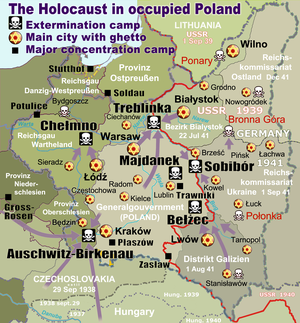 Extermination camps (or death camps) were camps during World War II (1939–45) built primarily but not exclusively by Nazi Germany to systematically kill millions of people by execution (primarily by gassing) and extreme work under starvation conditions. While there were victims from many groups, Jews were the main Nazi targets. This genocide of the Jewish people was the Third Reich's "Final Solution to the Jewish question".[1] The Nazi attempts at Jewish genocide are collectively known as the Holocaust.[2]
Extermination camps (or death camps) were camps during World War II (1939–45) built primarily but not exclusively by Nazi Germany to systematically kill millions of people by execution (primarily by gassing) and extreme work under starvation conditions. While there were victims from many groups, Jews were the main Nazi targets. This genocide of the Jewish people was the Third Reich's "Final Solution to the Jewish question".[1] The Nazi attempts at Jewish genocide are collectively known as the Holocaust.[2]
While not on the same scale as that prosecuted by the Nazis, the fascist Ustaše forces of the Independent State of Croatia also operated extermination camps.
The Nazis used the euphemism Endlösung der Judenfrage (Final Solution of the Jewish Question) to describe their systematic killing of Europe's Jews, which Nazi leaders likely decided during the first half of 1941. The initial, formal killings of the Final Solution were undertaken by the SS Einsatzgruppen (Task Forces) death squads who followed the Wehrmacht during the Operation Barbarossa invasion of the USSR in June 1941.
The terms extermination camp (Vernichtungslager) and death camp (Todeslager) are interchangeable usages, each referring to camps whose primary function was genocide, not for punishing crime or containing political prisoners, but for the systematic killing of the prisoners delivered there. The Nazis did not expect the majority of prisoners taken to the Belzec, Sobibor or Treblinka extermination camps to survive more than a few hours beyond arrival.[3] The first extermination camps were under the direct command of SS–Polizei-führer Globocnik, and operated by SS Police battalions andTrawnikis – volunteers from Eastern Europe.
These differed from concentration camps, such as Dachau and Belsen, which were initially prison camps for people defined as socially or politically undesirable in Nazi society. The SS-Totenkopfverbände managed the Nazi concentration camps such as Dachau and Ravensbrück. As early as September 1942, Dr. Johann Paul Kremer, M.D., an SS physician, witnessed a gassing of prisoners, and in his diary wrote: "They don't call Auschwitz the camp of annihilation [das Lager der Vernichtung] for nothing!"[4] The distinction was evident during the Nuremberg trials, when Dieter Wisliceny (a deputy to Adolf Eichmann) was asked to name the extermination camps, and he identified Auschwitz and Majdanek as such. Then, when asked "How do you classify the camps Mauthausen, Dachau, and Buchenwald?" he replied, "They were normal concentration camps, from the point of view of the department of Eichmann."[5]
Extermination camps are distinguished from the Arbeitslager (forced labor camps) established in German-occupied countries to use the prisoners, including prisoners of war, as slave labor. In most camps (excepting PoW camps for the non-Soviet soldiers and certain labor camps), the high death rates resulted from execution, starvation,disease, exhaustion, and physical brutality.
When the Nazis began to establish separate camps specifically for mass extermination, this was not a coordinated strategy. That changed with the Wannsee Conference chaired by Reinhard Heydrich in January 1942 in which the principle was made clear that the Jews of Europe were to be exterminated. Responsibility for the logistics were to be executed by the administrator, Adolf Eichmann.
In 1942, the Reichsführer Heinrich Himmler ordered the Lublin District SS- und Polizeiführer Odilo Globocnik to build the first extermination camps during "The Final Solution" (1941–43), the operation to annihilate every Jew in the General Government (occupied Poland). Initially, the victims' corpses were buried in mass graves, but later were cremated. After Russian forces began to advance, previously buried victims were also exhumed and burned in Sonderaktion 1005, a Nazi attempt to destroy evidence of the Holocaust.





























.jpg)











